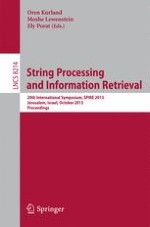2013 | Buch
String Processing and Information Retrieval
20th International Symposium, SPIRE 2013, Jerusalem, Israel, October 7-9, 2013, Proceedings
herausgegeben von: Oren Kurland, Moshe Lewenstein, Ely Porat
Verlag: Springer International Publishing
Buchreihe : Lecture Notes in Computer Science
